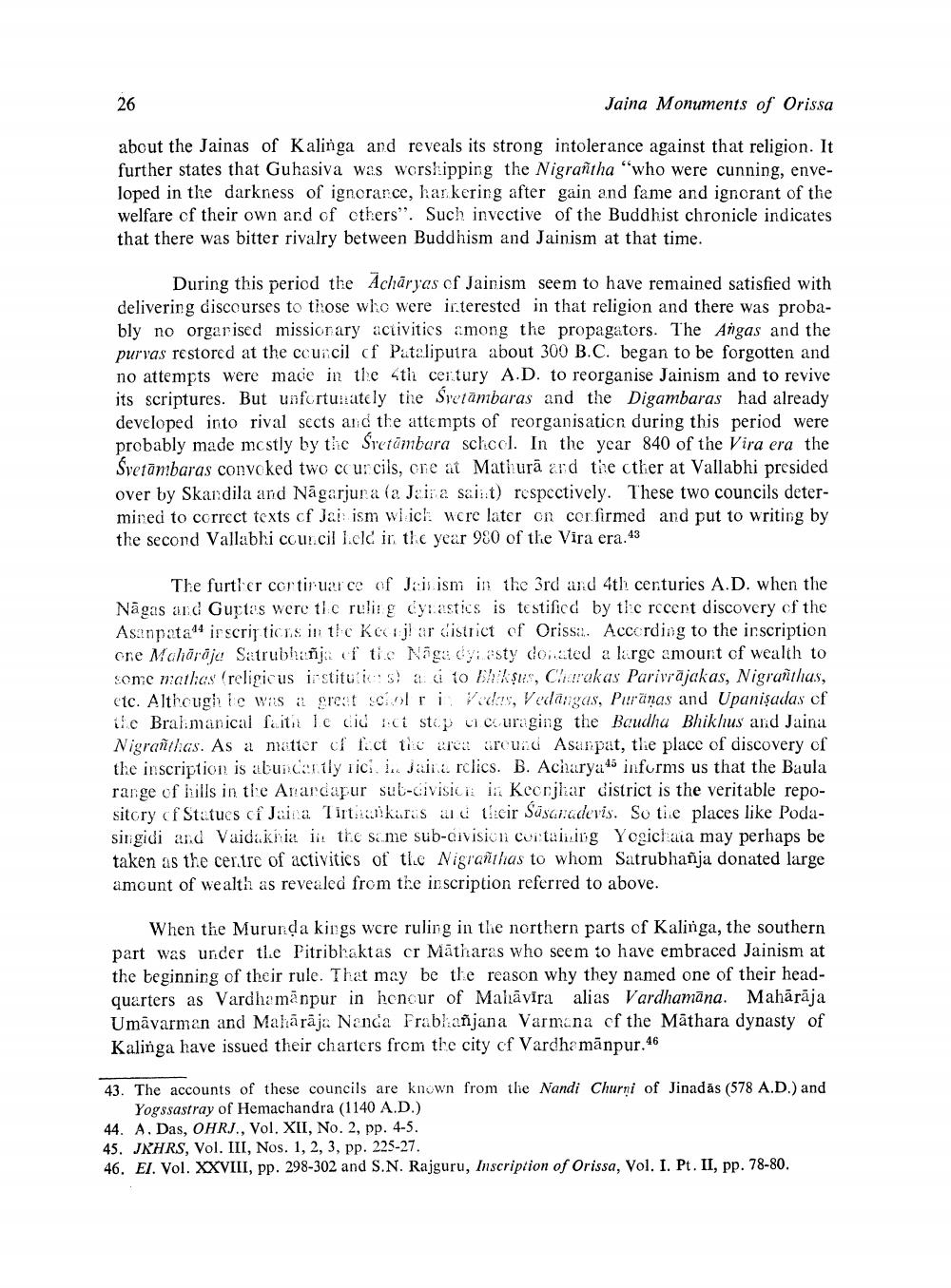________________
Jaina Monuments of Orissa
about the Jainas of Kalinga and reveals its strong intolerance against that religion. It further states that Guhasiva was worshipping the Nigrantha "who were cunning, enveloped in the darkness of ignorance, hankering after gain and fame and ignorant of the welfare of their own and of others". Such invective of the Buddhist chronicle indicates that there was bitter rivalry between Buddhism and Jainism at that time.
26
During this period the Acharyes of Jainism seem to have remained satisfied with delivering discourses to those who were interested in that religion and there was probably no organised missionary activities among the propagators. The Angas and the purvas restored at the council cf Patliputra about 300 B.C. began to be forgotten and no attempts were made in the 4th century A.D. to reorganise Jainism and to revive its scriptures. But unfortunately the Swetambaras and the Digambaras had already developed into rival sccts and the attempts of reorganisation during this period were probably made mostly by the Swetambara schcel. In the year 840 of the Vira era the Svetambaras convoked two councils, one at Mathura and the cther at Vallabhi presided over by Skandila and Nagarjuna (a Jeina saint) respectively. These two councils determined to correct texts cf Jainism which were later on confirmed and put to writing by the second Vallabhi council held in the year 980 of the Vira era.43
The further continuar ce of Jainism in the 3rd and 4th centuries A.D. when the Nagas and Guptes were the ruling dynastics is testified by the recent discovery of the Asunpata" inscrip ticus in the Kejar district of Orissa. According to the inscription one Mahārāja Satrubhanja of the Naga dynasty donated a large amount of wealth to some mathas (religious institutions) ad to Bhiksus, Charakas Parivrajakas, Nigranthas, etc. Although be was a great sciolri Vad, Vedangas, Puranas and Upanisadas of the Brahmanical faith le did not stop couraging the Baudha Bhikhus and Jaina Nigranthas. As a matter of fact the area areuad Asurpat, the place of discovery of the inscription is abundently riel. i. Jaina relics. B. Acharya informs us that the Baula range of hills in the Anandapur sub-civision in Keonjhar district is the veritable repository of Statues of Jain Tirthakares and their Sasanadevis. So the places like Podusingidi and Vaidaihia in the same sub-division containing Yogichaia may perhaps be taken as the centre of activitics of the Nigranthas to whom Satrubhanja donated large amount of wealth as revealed from the inscription referred to above.
45
When the Murunda kings were ruling in the northern parts of Kalinga, the southern part was under the Pitribhaktas cr Matharas who seem to have embraced Jainism at the beginning of their rule. That may be the reason why they named one of their headquarters as Vardhemanpur in honour of Mahavira alias Vardhamana. Mahārāja Umavarman and Maharaja Nenda Frablanjana Varmana of the Mathara dynasty of Kalinga have issued their charters from the city of Vardhamanpur."
43. The accounts of these councils are known from the Nandi Churni of Jinadas (578 A.D.) and Yogssastray of Hemachandra (1140 A.D.)
44. A. Das, OHRJ., Vol. XII, No. 2, pp. 4-5.
45. JKHRS, Vol. III, Nos. 1, 2, 3, pp. 225-27.
46. EI. Vol. XXVIII, pp. 298-302 and S.N. Rajguru, Inscription of Orissa, Vol. I. Pt. II, pp. 78-80.




